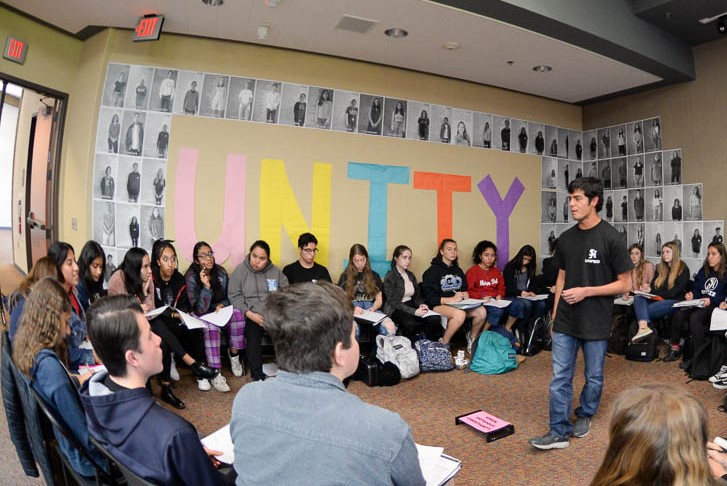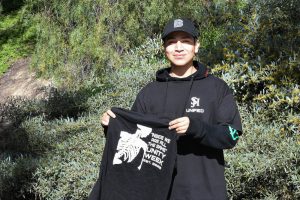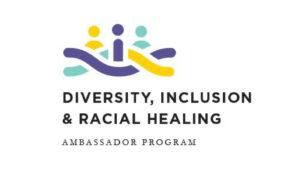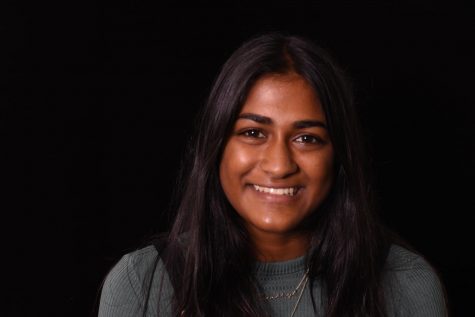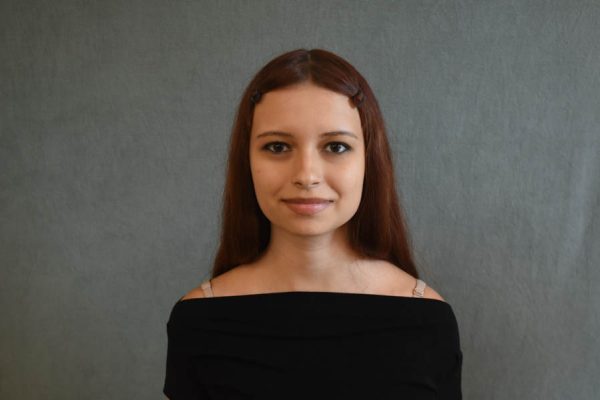DIRHA Hosts First Unity Week
Joseph Sgountzos (12) habla durante la semana de la Unidad sobre su fe, el cristianismo ortodoxo griego. El jueves, los estudiantes jugaron “Speed Faithing” reuniéndose alrededor de oradores que discutieron sus creencias religiosas para informar a los estudiantes sobre la diversidad de las religiones en el campus.
February 28, 2020
Driven by offers of extra credit in some cases or a desire to learn something new, hundreds of students flocked to the Theater Conference room to hear a series of talks about unifying our school by learning about diversity.
“We scheduled it in the Theater Conference Room because we didn’t think the response was going to be so great, said Jeffrey Tobar, event organizer.
To encourage students to attend the event, many teachers offered extra credit. This piqued interest so much that maximum capacity was quickly reached everyday.
“I went for extra credit, honestly,” said senior, Ashli Reichner. “But, I was turned away. Maybe like 40 or 50 people were turned away.” she added.
Some suggested the Theater as a better venue for the event.
“The problem is we can’t eat in the Theater,” said organizer Jeffrey Tobar.
“It was sad that some people only came for the credit and that some who really wanted to be there couldn’t get in,” he said. “But some people who were there for extra credit might have actually gotten something out of it simply by being there,” he added.
“We should do it in the gym next year,” said senior, Kylee Rogers.
The week of activities highlighted not only how we are different, but how sensitivity to those differences can make SJHHS better. Diversity Inclusion and Racial Healing Ambassadors (DIRHA) ran the activities for Unity Week.
Monday’s focus was a topic on race and ethnicity, and featured a talk by Qunisa Daniel, of Breakthrough San Juan about microaggressions, things we often say or do that can have unintended harmful effects on others.
The goal of the seminar was to reduce racism and speak up about stereotypes in order to create a safe space for everyone.
Microaggressions are statements or actions with subtle, and usually unintentional discrimination towards marginalized groups.
Microaggressions might include continuing to mispronounce someone’s name even after they have corrected the person time and time again, telling someone that they are exotic looking, or clutching a purse when a black person approaches.
These statements and actions have underlying connotations and messages behind them. Clutching a purse when a black person approaches conveys the idea that the black person is going to steal, they are poor, they do not belong, or they are dangerous simply because of the color of their skin.
Tuesday’s focus was all about immigration and had one featured speaker, Robert Herrera, who works with Resilience Orange County. Resilliance O.C. is a group designed to reform and create institutions that aid youth development and end the schools-to-prison pipeline. They work with organizations affiliated with youth centered social justice and restorative justice.
Herrera spoke about the experiences of youth in Santa Ana who have limited options in terms of programs outside the school day to provide positive focus for youth. According to a budget analysis by Resilience O.C., in 2017 the city of Santa Ana spent $19.55 million on policing and 15.3 million on city sponsored youth development programs.
He also showed a video made by a young person inside her home as ICE agents attempted entry without a warrant. The woman kept her cool, didn’t open the door or disclose her identity. She also had the presence of mind to record the incident.
In addition, the Coalition for Immigrant Rights Los Angeles (CHIRLA) had an informational booth set up.
Wednesday was about gender identity and sexuality, and was sponsored by the Queer Alliance club with Ms. Serio, the QA advisor. Serio just finished her masters on LGBTQ+ student help and intervention. She has taken a lot of interest in what teachers could be doing in their classrooms on a daily basis to be more welcoming and accommodating towards LGBTQ+ students, and increase empathy from non LGBTQ+ students.
Some ideas included learning about the range of sexualities and thinking of it as a continuum, or spectrum, using appropriate pronouns for people, speaking out against prejudice, and being a good listener.
89.5% of transgender students report feeling unsafe at school, and 82% reported that faculty/staff either never intervened or sometimes intervened when they heard other students make derogatory remarks, according to a national study cited in the presentation.
Thursday focused on religion, with a variety of different speakers from five different faiths represented.One speaker, senior Lian Zhu, represented Pure Land Buddhism.
“Unity week exists to bring attention to the idea of diversity and other cultures and shine it in a positive way. And that’s one of the biggest reasons why I chose to participate in unity week,” said Zhu.
The presentations followed a clever format called “speed faithing” where the speakers rotated around the room to different circles of students ready to hear their messages about faith and religious systems.
Other presenters included Lauren Hart representing Christianity, Colin Longmore & Esther Ocampo for the Roman Catholic faith, and Edlin Garcia spoke about agnosticism, which is not knowing if there is a God.
Islam and Judaism were not represented because speakers could not be found who were willing to come forward for the event.
Ingrid Martinez and Adriana Monroy served as masters of ceremony. Ashley Ortega and Jimena Petronilo helped out and will take over next year.
“I believe that in future years Unity Week will create a safe space for self expression and reduce the feeling of needing to change who you are just so you could fit in. Slowly but surely, I believe that we all will appreciate and love each other for who we are. United we stand taller,” said Tobar.
Tobar believes the most unique thing about Unity Week was how it brought people together to invest time in something he believed to be beneficial to the student body.
“It started with an idea, to a group of students, to a club, to administration and staff, and now half of the school. Unity Week will bring light and hope to many folks. SJHHS will be a great representation of tackling challenges based on a false human hierarchy,” said Tobar.
DIHRA meticulously planned the week over the past months. It was specifically designed to address SJHHS’ campus, which is unique in its blend of ethnicities, cultures, and sexual identities, as demonstrated by a school survey DIRHA conducted last year.
“We attended monthly seminars from which we learn about different social issues. Our task as ambassadors was to create a project based on data that we collected from surveys on our campus. From that data we were able to see what challenges needed to be addressed. After heavy weeks of planning and discussion, Unity Week was designed,” said Tobar.
DIRHA collaborated with the Kindness Club, BRIDGES, Latinx, CHIRLA, the Queer Alliance club, and ASB to make this a successful and campus wide event.
While this is the first time Unity Week occured at SJHHS, DIRHA member Uzziel Sanchez wants to make it an annual event, as it was very popular this year.

